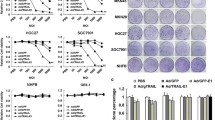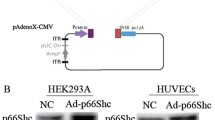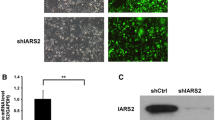Abstract
Objective
The aim of the research was to study the function of human yrdC gene in the gastric carcinoma cells.
Methods
Human yrdC gene was isolated from human spleen tissue by RT-PCR. Anti-human yrdC monoclonal antibody was prepared by hybridoma cell technique. Recombinant adenovirus Ad.yrdC carrying yrdC gene was constructed by using the AdEasy adenoviral vector system. Recombinant adenovirus Ad.yrdCshRNA mediated yrdCshRNA was prepared by RNA interference technology. Gastric adenocarcinoma BGC-823 cells of moderate differentiation were transfected and absorbance of the transfected cells was calculated at 490 nm by methyl thiazolyl tetrazolium (MTT) method.
Results
A value of the transfected Ad.yrdC group was significantly greater than that of the non-transfected and transfected Ad.Null groups, and A value of Ad.yrdCshRNA group was significantly lower than that of the non-transfected and transfected Ad.Null groups.
Conclusion
Expression of yrdC gene has a function of promoting the proliferation of gastric carcinoma cells.
Similar content being viewed by others
References
Chen JZ, Ji CN, Gu SH, et al. Isolation and identification of a novel cDNA that encodes human yrdC protein. J Hum Genet, 2003, 48: 164–169.
Chen JZ, Yang QS, Wang S, et al. Cloning and expression of a novel retinoblastoma binding protein cDNA, RBBP10. Biochem Genet, 2002, 40: 273–282.
Harlow E, David L. Antibodies: a laboratory manual. New York: Cold Spring Harbor Lab Press, 1998. 139–244.
Claudio PP, Tonini T, Giordano A. The retinoblastoma family: twins or distant cousins? Genome Biol, 2002, 3: 3012.
Helt AM, Galloway DA. Mechanisms by which DNA tumor virus oncoproteins target the Rb family of pocket proteins. Carcinogenesis, 2003, 24: 159–169.
Classon M, Harlow E. The retinoblastoma tumour suppressor in development and cancer. Nat Rev Cancer, 2002, 2: 910–917.
Möller W, Schipper A, Amons R. A conserved amino acid sequence around Arg-68 of Artemia elongation factor 1 alpha is involved in the binding of guanine nucleotides and aminoacyl transfer RNAs. Biochimie, 1987, 69: 983–989.
Moldave K. Eukaryotic protein synthesis. Annu Rev Biochem, 1985, 54: 1109–1149.
Lee S, Francoeur AM, Liu S, et al. Tissue-special expression in mammalian brain, heart, and muscle of S1, a member of the elongation factor-1 alpha gene family. J Biol Chem, 1992, 267: 24064–24068.
Hoshino S, Miyazawa H, Enomoto T, et al. A human homologue of the yeast GST1 gene codes for a GTP-binding protein and is expressed in a proliferation-dependent manner in mammalian cells. EMBO J, 1989, 8: 3807–3814.
Zahnow CA. CCAAT/enhancer binding proteins in normal mammary development and breast cancer. Breast Cancer Res, 2002, 4: 113–121.
Busch SJ, Sassone-Corsi P. Dimers, leucine zippers and DNA-binding domains. Trends Genet, 1990, 6: 36–40.
Teplova M, Tereshko V, Sanishvili R, et al. The structure of the yrdC gene product from Escherichia coli reveals a new fold and suggests a role in RNA binding. Protein Sci, 2000, 9: 2557–2566.
Jia J, Lunin VV, Sauve V, et al. Crystal structure of the YciO protein from Escherichia coli. Proteins, 2002, 49: 139–141.
Na JG, Pinto I, Hampsey M. Isolation and characterization of SUA5, a novel gene required for normal growth in Saccharomyces cerevisiae. Genetics, 1992, 131: 791–801.
Kaczanowska M, Rydén-Aulin M. The yrdC protein — a putative ribosome maturation factor. Biochim Biophys Acta, 2005, 1727: 87–96.
Kaczanowska M, Rydén-Aulin M. Temperature sensitivity caused by mutant release factor 1 is suppressed by mutations that affect 16S rRNA maturation. J Bacteriol, 2004, 186: 3046–3055.
Jiang W, Prokopenko O, Wong L, et al. IRIP, a new ischemia/reperfusion-inducible protein that participates in the regulation of transporter activity. Mol Cell Biol, 2005, 25: 6496–6508.
El Yacoubi B, Lyons B, Cruz Y, et al. The universal YrdC/Sua5 family is required for the formation of threonylcarbamoyladenosine in tRNA. Nucleic Acids Res, 2009, 37: 2894–2909.
Author information
Authors and Affiliations
Corresponding author
Additional information
Supported by a grant from the General Program of National Natural Science Foundation of China (No. 30371403).
Rights and permissions
About this article
Cite this article
Yang, T., Shen, X., Bi, J. et al. Expression of human yrdC gene promotes proliferation of gastric carcinoma cells. Chin. -Ger. J. Clin. Oncol. 8, 433–437 (2009). https://doi.org/10.1007/s10330-009-0046-2
Received:
Revised:
Accepted:
Published:
Issue Date:
DOI: https://doi.org/10.1007/s10330-009-0046-2




